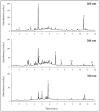Screening of Wood/Forest and Vine By-Products as Sources of New Drugs for Sustainable Strategies to Control Fusarium graminearum and the Production of Mycotoxins
- PMID: 33466739
- PMCID: PMC7830912
- DOI: 10.3390/molecules26020405
Screening of Wood/Forest and Vine By-Products as Sources of New Drugs for Sustainable Strategies to Control Fusarium graminearum and the Production of Mycotoxins
Abstract
Fusarium graminearum is a fungal pathogen that can colonize small-grain cereals and maize and secrete type B trichothecene (TCTB) mycotoxins. The development of environmental-friendly strategies guaranteeing the safety of food and feed is a key challenge facing agriculture today. One of these strategies lies on the promising capacity of products issued from natural sources to counteract crop pests. In this work, the in vitro efficiency of sixteen extracts obtained from eight natural sources using subcritical water extraction at two temperatures was assessed against fungal growth and TCTB production by F. graminearum. Maritime pine sawdust extract was shown to be extremely efficient, leading to a significant inhibition of up to 89% of the fungal growth and up to 65% reduction of the mycotoxin production by F. graminearum. Liquid chromatography/mass spectrometry analysis of this active extract revealed the presence of three families of phenolics with a predominance of methylated compounds and suggested that the abundance of methylated structures, and therefore of hydrophobic compounds, could be a primary factor underpinning the activity of the maritime pine sawdust extract. Altogether, our data support that wood/forest by-products could be promising sources of bioactive compounds for controlling F. graminearum and its production of mycotoxins.
Keywords: Fusarium graminearum; biofungicides; ecological strategies; natural extracts; type B trichothecenes.
Conflict of interest statement
The authors declare no conflict of interest.
Figures





References
MeSH terms
Substances
Supplementary concepts
Grants and funding
LinkOut - more resources
Full Text Sources
Other Literature Sources
Medical

